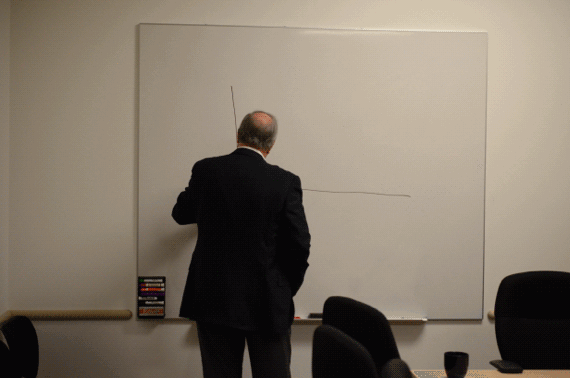Richard Feynman and The Connection Machine - The Long Now
Jared Sperli stashed this in science
Stashed in: History of Tech!, Caltech, Feynman, Richard Feynman
Feynman worked out the program for computing Hopfield's network on the Connection Machine in some detail. The part that he was proudest of was the subroutine for computing logarithms. I mention it here not only because it is a clever algorithm, but also because it is a specific contribution Richard made to the mainstream of computer science. He invented it at Los Alamos.
Consider the problem of finding the logarithm of a fractional number between 1.0 and 2.0 (the algorithm can be generalized without too much difficulty). Feynman observed that any such number can be uniquely represented as a product of numbers of the form $1 + 2^{-k]$, where $k$ is an integer. Testing each of these factors in a binary number representation is simply a matter of a shift and a subtraction. Once the factors are determined, the logarithm can be computed by adding together the precomputed logarithms of the factors. The algorithm fit especially well on the Connection Machine, since the small table of the logarithms of $1 + 2^{-k]$ could be shared by all the processors. The entire computation took less time than division.
Concentrating on the algorithm for a basic arithmetic operation was typical of Richard's approach. He loved the details. In studying the router, he paid attention to the action of each individual gate and in writing a program he insisted on understanding the implementation of every instruction. He distrusted abstractions that could not be directly related to the facts. When several years later I wrote a general interest article on the Connection Machine for [Scientific American], he was disappointed that it left out too many details. He asked, "How is anyone supposed to know that this isn't just a bunch of crap?"
Feynman's insistence on looking at the details helped us discover the potential of the machine for numerical computing and physical simulation. We had convinced ourselves at the time that the Connection Machine would not be efficient at "number-crunching," because the first prototype had no special hardware for vectors or floating point arithmetic. Both of these were "known" to be requirements for number-crunching. Feynman decided to test this assumption on a problem that he was familiar with in detail: quantum chromodynamics.
The 64,000 processor Connection Machine supercomputer has a special place in the history of Caltech:
Quantum chromodynamics is a theory of the internal workings of atomic particles such as protons. Using this theory it is possible, in principle, to compute the values of measurable physical quantities, such as a proton's mass. In practice, such a computation requires so much arithmetic that it could keep the fastest computers in the world busy for years. One way to do this calculation is to use a discrete four-dimensional lattice to model a section of space-time. Finding the solution involves adding up the contributions of all of the possible configurations of certain matrices on the links of the lattice, or at least some large representative sample. (This is essentially a Feynman path integral.) The thing that makes this so difficult is that calculating the contribution of even a single configuration involves multiplying the matrices around every little loop in the lattice, and the number of loops grows as the fourth power of the lattice size. Since all of these multiplications can take place concurrently, there is plenty of opportunity to keep all 64,000 processors busy.
To find out how well this would work in practice, Feynman had to write a computer program for QCD. Since the only computer language Richard was really familiar with was Basic, he made up a parallel version of Basic in which he wrote the program and then simulated it by hand to estimate how fast it would run on the Connection Machine.
He was excited by the results. "Hey Danny, you're not going to believe this, but that machine of yours can actually do something [useful]!" According to Feynman's calculations, the Connection Machine, even without any special hardware for floating point arithmetic, would outperform a machine that CalTech was building for doing QCD calculations. From that point on, Richard pushed us more and more toward looking at numerical applications of the machine.












7:40 PM Jun 15 2013